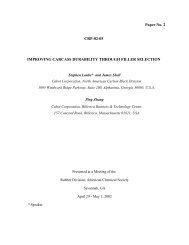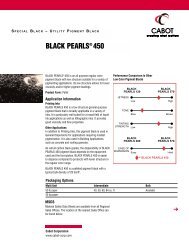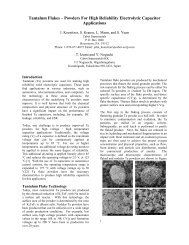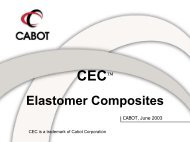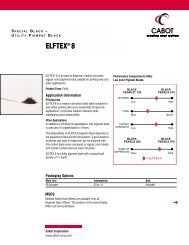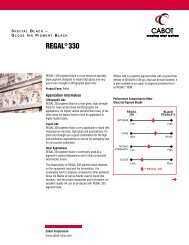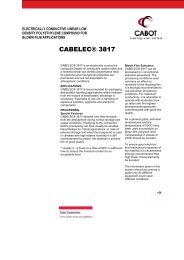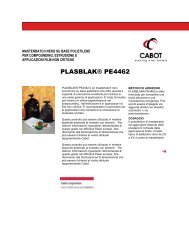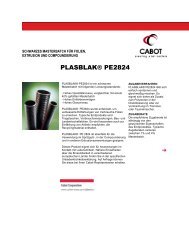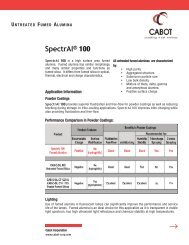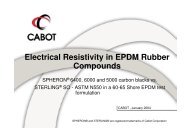Color Measurement for Carbon Black Filled Plastics - Cabot ...
Color Measurement for Carbon Black Filled Plastics - Cabot ...
Color Measurement for Carbon Black Filled Plastics - Cabot ...
You also want an ePaper? Increase the reach of your titles
YUMPU automatically turns print PDFs into web optimized ePapers that Google loves.
<strong>Color</strong> <strong>Measurement</strong> <strong>for</strong><strong>Carbon</strong> <strong>Black</strong> <strong>Filled</strong> <strong>Plastics</strong>
The X, Y, and Z values are the raw data <strong>for</strong> color measurement scales.These values do not directly correlate to color as perceived by thehuman observer; there<strong>for</strong>e they need to be used to calculate colorvalues which are commonly used in the industry today.L+ white<strong>Color</strong> scientists have created many color scales throughout history.This document will concentrate on two color scales that are used inthe plastics industry today.In 1976 CIE recommended the CIELAB color scale which measurescolor using three coordinates, the L*, a*, and b*.The other color scale to be discussed is from Hunter in 1958. TheHunter color scale also measures color using three coordinates,which are LH, aH, and bH. For both color scales, the L valuerepresents white to black or lightness to darkness, the a valuerepresents red to green, and the b value represents yellow to blue.The differences between the two scales are the calculations that usethe X, Y, and Z values from the spectral curve. Most moderncolorimeters automatically calculate either the CIELAB values or theHunter values. Table 1 compares the CIELAB and Hunter color<strong>for</strong>mulasgreena-b- blueL+ blackb+ yellowa+redCIELAB1976Table 1: Comparison of <strong>Color</strong> FormulasHunter L, a, b (1958) CIE 1976 L* a* b*L = 100(Y/Yn) 1/2 L* = 116(Y/Yn) 1/3 - 16a = Ka ϒ (X/Xn – Y/Yn)/ (Y/Yn) 1/2 a* = 500[(X/Xn) 1/3 – (Y/Yn) 1/3 ]b = Kb ϒ (Y/Yn –Z/Zn)/ (Y/Yn) 1/2 b* = 200[(Y/Yn) 1/3 – (Z/Zn) 1/3 ]ϒKa and Kb are chromaticity coefficients <strong>for</strong> the illuminants used, see ASTM E308<strong>Color</strong> Difference <strong>Measurement</strong>s <strong>for</strong> <strong>Carbon</strong> <strong>Black</strong> <strong>Filled</strong><strong>Plastics</strong>Many evaluations require a comparison of a color versus a standardcontrol. A common measurement used is Delta E.∆E = [(∆L*) 2 + (∆a*) 2 + (∆b*) 2 ] 1/2This value gives a single scalar value that can be used to determine ifa color is within tolerance of a specification. A problem with the DeltaE measurement is that it does not show which direction the color isout of tolerance. For carbon black filled thermoplastics, a much bettermeasurement to use would be Delta L, which will give a magnitudeand direction of the difference in black color strength.∆L* = L*1 – L*0If blue undertone is a critical quality to the carbon black filled part,Delta b* would also be a useful measurement versus the controlmaterial.∆b* = b*1 – b*0
The Standard Observer refers to the size of the observer’s field ofview. The 10° observer is most common in industry and wasrecommended by CIE in 1964. The 2° observer was the observerrepresented by CIE in 1931.Detector<strong>Color</strong>imeter measurement geometry refers to the configuration ofthe colorimeter as well as the locations of the light source andobserver relative to the object. Common geometries used are the CIE45/0, CIE 0/45 and the d/8° <strong>for</strong> sphere geometry colorimeters.Illuminant45°For spherical colorimeters where the d/8° geometry is used, specularreflection inclusion or exclusion should be specified. When light hits ablue, opaque, non-metal object, the blue wavelengths are reflected indiffuse reflection. The gloss or shiny reflection would be representedin the specular reflection. When specular reflection is included in themeasurement, only differences in color are observed. Differences ingloss and haze, surface effects, dispersion etc. are not detectedwhen specular reflection is included. When specular reflection isexcluded in the measurement, differences in surface appearance aremore likely to be detected because the instrument is measuring onlythe diffuse reflection. Effects of dispersion, gloss, waviness, etc.would be more likely to be captured with specular excludedmeasurements.DetectorObjectCIE 45/0 GeometrySpecular Port CoverSample Preparation needs to be specified to keep resultsconsistent from study to study or sample to sample. Some variablesto take note of are which side of the sample is tested, what type ofmold is used to make the sample, the finish on the mold, processconditions etc. In general, when testing samples, try to keep samplepreparation and the equipment used consistent. Changingpreparation procedures and process equipment adds anothervariable to consider if the data is unusual.Objectd/8° GeometryIlluminantThe above variables are very important in influencing color data. <strong>Color</strong>differences obtained from the same sample could be caused byvariations in the above test measurement variables. It is veryimportant that the same conditions are used when color data iscompared.The above in<strong>for</strong>mation is presented to provide a general, practicalbackground on color measurement using colorimeters. It should alsobe noted that colorimeters are great tools to generate quantitativedata <strong>for</strong> research and quality assurance; however, visual appraisalshould always be used to validate the conclusions drawn fromquantitative data. At the end of the supply chain, it will be aconsumer’s eye that makes the final assessment.LightSourceDiffuseReflectionSpecularReflectionReferences• Harold, R. W. "Byk-Gardner Presents <strong>Color</strong> and Appearance," PresentedJune 6, 2001 Sturbridge, Massachusetts• ASTM D 2244 – 93, "Standard Test Method <strong>for</strong> Calculation of <strong>Color</strong>Differences from Instrumentally Measured <strong>Color</strong> Coordinates"• X-Rite Incorporated, "A Guide to Understanding <strong>Color</strong> Communication," X-Rite Incorporated 1993• Wyszecki & Stiles, <strong>Color</strong> Science, John Wiley and Sons, Inc 19675
CB/COL.MEAS/12.01/ENorth America:<strong>Cabot</strong> CorporationBusiness and Technical Center157 Concord RoadBillerica, MA 01821-7001USATel: (978) 663-3455Tel: (800) 462-2313 (Technical Service)Fax: (978) 670-7035 (Technical Service)Tel: (800) 526-7591 (North America CustomerService)South America:<strong>Cabot</strong> Brasil Industria e Comercio LtdaAv. Joao Castaldi 8804517-900 Sao Paulo, SPBRAZILTel: +55 11 5536 0388Fax: +55 11 5542 6037Europe:<strong>Cabot</strong>Interleuvenlaan, 5B - 3001 LeuvenBELGIUMTel: +32 16 39 24 00Fax: +32 16 39 24 21Pacific/Asia:<strong>Cabot</strong> Specialty Chemicals, Inc.Level 14, MNI Tower 211, Jalang Pinang50450 Kuala LumpurMALAYSIATel: +60 3 2164-8352Fax: +60 3 2162-0253Middle East/Africa:<strong>Cabot</strong> Specialty Chem. Inc.Jebel Ali Free ZoneLOB 15, Office 424DubaiUNITED ARAB EMIRATESTel: +971 4 8871 1800Fax: +971 4 8871 1801This in<strong>for</strong>mation is provided as a convenience and <strong>for</strong> in<strong>for</strong>mational purposes only. No guarantee orwarranty as to this in<strong>for</strong>mation, or any product to which it relates, is given or implied. This in<strong>for</strong>mationmay contain inaccuracies, errors or omissions and CABOT DISCLAIMS ALL WARRANTIES EXPRESSOR IMPLIED, INCLUDING MERCHANTABILITY OR FITNESS FOR A PARTICULAR PURPOSE AS TO(i) SUCH INFORMATION, (ii) ANY PRODUCT OR (iii) INTELLECTUAL PROPERTY INFRINGEMENT. In noevent is <strong>Cabot</strong> responsible <strong>for</strong>, and <strong>Cabot</strong> does not accept and hereby disclaims liability <strong>for</strong>, any damageswhatsoever in connection with the use of or reliance on this in<strong>for</strong>mation or any product to which it relates.© <strong>Cabot</strong> Corporation, Boston, MA U.S.A. All rights reserved.BLACK PEARLS® and VULCAN® are registered trademarks of <strong>Cabot</strong> Corporation.www.cabot-corp.com/plastics



